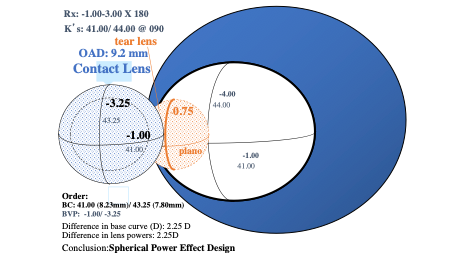Bitoric Spherical Power Effect: Thomas G. Quinn, OD, MS, FAAO
Background
PE was a 22-year-old waitress interested in contact lenses.
Test Procedures, Fitting/Refitting, Design and Ordering
Manifest Refraction:
OD: -1.00-3.00 X 180 20/20
OS: -2.00-3.00 X 175 20/20
Keratometry Readings:
OD: 41.00 @ 180; 44.00 @ 090
OS: 43.00 @ 175; 45.50 @ 085
Spherical Diagnostic Lens Applied OD:
| BCR | OAD/OZD | Power | CT |
| 8.03mm (42.00D) | 9.2/7.8mm | -2.00D | .16mm |
BCR = Base Curve Radius
OAD/OZD = Overall Diameter/Optical Zone Diameter
CT = Center Thickness

Design of Toric GP:
1. Overall Diameter selection: Since upper lid covers upper limbus, attempt lid attachment, so bias diameter large. Patient has small aperture, so select intermediate diameter: 9.2 mm
2. Base curve radii selection: Fit horizontal meridian near alignment, vertical meridian slightly flat to promote vertical lens movement with blink (see table).
Recommended Toric GP:
Base Curve Radii Selection with Varying Lens Diameter
Base Curve/Cornea Relationship:
| Lens Diameter (mm) | Horizontal | Vertical |
| Small (8.0 to 8.6) | 0.25 D STK | 0.50 D FTK |
| Intermediate (8.7 to 9.3) | On K | 0.75 D FTK |
| Large (9.4 to 10.2) | 0.25 D FTK | 1.00 D FTK |
Base Curve Radii Chosen:
OD: 41.00 (8.23mm)/ 43.25 (7.80mm)
OS: 43.00 (7.85mm)/ 44.75 (7.54mm)
3. Power Selection: Adjust spectacle power:
a) for vertex effects in any meridian with power greater than -4.00
b) to account for tear lens power by amount of tear lens power (see summary diagram for OD)
OD: -1.00/ -3.25
OS: -2.00/ -4.00
Lens Design Analysis:
If the difference in base curve power (BCR) between major meridians is equal to the difference in lens power (BVP) between major meridians, then the lens is a Spherical Power Effect (SPE) Bitoric Design and you do not need to be concerned about lens rotation.
| OD: | Difference between BCR (41.00 / 43.25) = 2.25 D |
| Difference between BVP (-1.00/-3.25) = 2.25 D | |
| OS: | Difference between BCR (43.00 / 44.75) = 1.75D |
| Difference between BVP (-2.00/ -3.75) = 1.75D | |
| Adjust power to -2.00/ -3.75 so difference = 1.75 D |

Patient Education/Consultation
When the refraction was completed, visual acuity through the phoropter with and without cylinder correction was demonstrated to show need to correct astigmatism. This helps the patient understand the need for a special lens design.
Follow-Up Care/Final Outcome
Patient experienced excellent vision with a stable, well positioned lens (see photo below).

Discussion/Alternative Management Options
A spherical corneal GP lens positioned poorly, so a toric GP lens was designed to provide an optimal fit. When power was calculated, it was determined that the difference in power between the two meridians of the right lens was equal to the difference in base curves in the lens. When this relationship exists it is a SPE bitoric design, which can rotate without adversely affecting vision. A toric soft lens was not chosen due to the high degree of astigmatism relative to the spherical refractive error. Any rotation of such a toric lens would result in variable vision.
Back to Table of Contents
